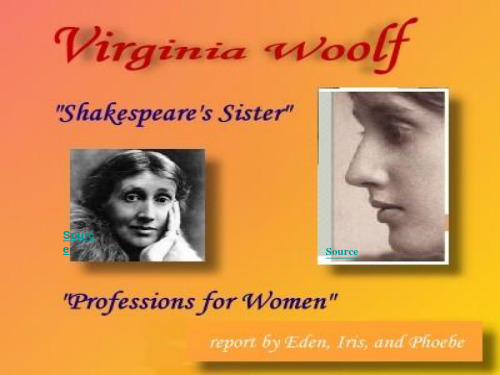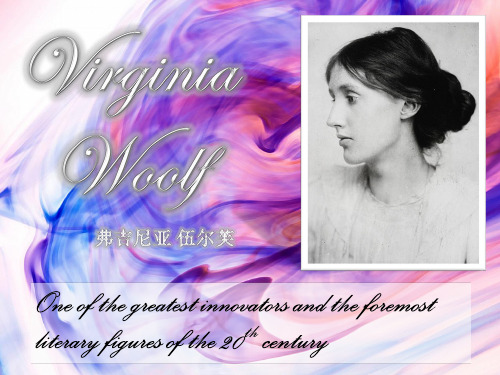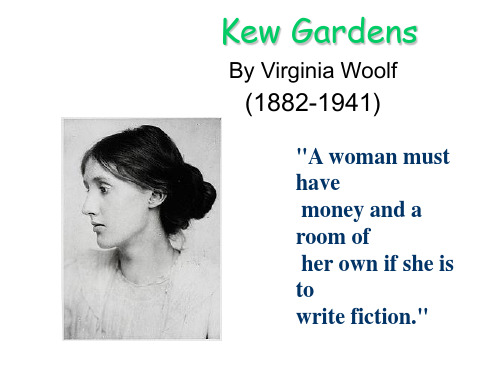关于伍尔夫的英文介绍
- 格式:ppt
- 大小:2.65 MB
- 文档页数:10


作文素材:弗吉尼亚·伍尔芙:伟大的灵魂都是雌雄同体弗吉尼亚·伍尔芙(Adeline Virginia Woolf,1882-1941),英国女作家、文学批评家和文学理论家。
她是意识流文学的代表人物,被誉为二十世纪现代主义与女性主义的先锋,代表作有《达洛维夫人》《到灯塔去》等。
1. 人不应该是插在花瓶里供人观赏的静物,而是蔓延在草原上随风起舞的韵律。
生命不是安排,而是追求,人生的意义也许永远没有答案,但也要尽情感受这种没有答案的人生。
2. 一个人能使自己成为自己,比什么都重要。
3. 一个人一旦有了自我认识,也就有了独立人格,而一旦有了独立人格,也就不再浑浑噩噩,虚度年华了。
换言之,他一生都会有一种适度的充实感和幸福感。
4. 记住我们共同走过的岁月。
记住爱,记住时光。
5. 夕阳西下,清晰的轮廓消失了,寂静像雾霭一般袅袅上升、弥漫扩散,风停树静,整个世界松弛地摇晃着躺下来安睡了……6. 出来找乐子的男人,碰到用情太深的女人,犹如钓鱼钓到白鲸。
7. 他人的眼睛是我们的监狱,他人的思想是我们的牢笼。
8. 她面对着一望无际的蔚蓝色的大海;那灰白色的灯塔,矗立在远处朦胧的烟光雾色之中;在右边,视力所及之处,是那披覆着野草的绿色沙丘,它在海水的激荡下渐渐崩塌,形成一道道柔和、低回的皱折;那夹带泥沙的海水,好像不停地向杳无人烟的仙乡梦国奔流。
9. 这时她用不着顾忌任何人,她可以独处,可以处于自然状态。
这正是现在她常常感到需要的——思考;哦,甚至连思考也不要。
只要静默;独自一人,一切外扩的、绚丽的、语言的存在和行为都消失了;人怀着庄严感缩回自我,一个楔形的隐秘的内核,是别人所看不见的。
尽管她直挺挺地坐着,仍继续在织袜子,但正是这样她感受到了自我;而这个摆脱了一切身外附属之物的自我可以自由地从事最奇特的冒险。
10. 当生活的活跃程度暂时减低时,体验的领域显得无边无涯。
11. 伟大的灵魂都是雌雄同体。




弗吉尼亚·伍尔夫(Virginia Woolf),1882 --1941,英国著名女作家,在小说创作和文学评论两方面都有卓越的贡献。
世界三大意识流作家之一,女权主义运动的先驱人物。
深受弗洛伊德心理学、女性主义及同性恋运动影响。
1882.1.25 伍尔夫出生于英国伦敦,肯辛顿,海德公园门(Hyde Park Gate)22号,原名弗吉尼亚·斯蒂芬(Adeline Virginia Stephen)。
父亲莱斯利·斯蒂芬爵士(Leslie Stephen)是维多利亚时代出身于剑桥的一位著名的文学评论家、学者和传记家。
母亲是Julia Prinsep Jackson Stephen。
父母亲在结婚前都曾有过一次婚姻,父亲与前妻有一個女儿Stella,母亲与前夫有三个孩子。
父母结合后又生下四个孩子:V anessa, Thoby, 伍尔夫和Adrian。
伍尔夫在家接受教育。
1895.5 母亲Julia去世,伍尔夫第一次精神崩溃。
1904年2月,伍尔夫的父亲去世。
5月,伍尔夫第二次精神崩溃,并试图跳窗自杀。
1904年末和Vanessa, Thoby, Adrian搬到布卢姆斯伯里的戈登广场46号(46 Gordon Square, Bloomsbury)。
12月14日,弗吉尼亚在《卫报》上第一次发表作品——一篇未署名的书评。
后出版了第一批散文,并开始经常性地为《时代文学增刊》(《Times Literary Supplement》)写书评,同时在一间在职成人夜校Morley College任教。
Thoby的‘Thursday Evenings’宣告布卢姆斯伯里组织(Bloomsbury Group)的成立,伍尔夫是其中的主将。
著名的布卢姆斯伯里团体——一个知识精英的沙龙,其核心成员有:作家伦纳德·伍尔夫(弗吉尼亚的丈夫),艺术批评家克莱夫·贝尔(范妮莎的丈夫),传记作家利顿·斯特雷奇,文学批评家德斯蒙德·麦卡锡,经济学家约翰·梅纳德·凯恩斯,画家邓肯·格兰特,艺术批评家罗杰·弗莱,作家福斯特。
【VirginiaWoolf】弗吉尼亚·伍尔芙意识流的一生英国邦利弗吉尼亚·伍尔芙(Virginia Woolf),许多人因为电影《时时刻刻》而了解她,诞生了三位影后级人物、奥斯卡金像奖。
原著作者为迈克尔·坎宁安(Michael Cunningham),是介绍不同时期、不同地方女性生活状况的小说,其中一位就是弗吉尼亚·伍尔芙。
该书不仅登上了《纽约时报》畅销书榜,同时获得“普利策小说奖”和“笔会/福克纳奖”的双项殊荣。
究竟是一位什么样的人物,使得根据她的故事而创作的电影及小说都能大获成功呢?弗吉尼亚·伍尔芙简介弗吉尼亚·伍尔芙生于1882年,死于1941年。
英国女作家、文学批评家和文学理论家,意识流文学代表人物,被誉为二十世纪现代主义与女性主义的先锋,也是在中国享有盛誉的英国五位女作家之一。
她的第一部小说为《远航》,知名小说包括《达洛维夫人》、《到灯塔去》,1941年完成她的最后一部作品《幕间》,随后自杀。
遗作《幕间》由她丈夫伦纳德整理并出版。
伍尔芙所受的赞誉爱德华·摩根·福斯特(E. M. Forster)称她将英语“朝着光明的方向推进了一小步”。
她革新了英语语言,尝试用意识流的写作方法,她同当时的詹姆斯·乔伊斯、法国的普鲁斯特等作家,把意识流文学推向世界,他们的出现成为了传统文学和现代文学的一个分水岭。
英国作家多丽丝·莱辛认为她在追求真理,但是追求真理的女作家当时并不被人理解。
弗吉尼亚虽然强调独特的女性意识,要求女性成为自己,但她并没有试图去营造一种纯粹的、封闭的、根植于所谓女性本质的女性主义诗学理论,相反,它呈现出开放的趋势。
有人曾这样描述她,“她的记忆有着隐秘的两面:一面澄明,一面黑暗;一面寒冷,一面温热;一面是创造,一面是毁灭;一面铺洒着天堂之火,一面燃烧着地狱之火。
”她终生为癫痫所困,她的精神崩溃令她显得神经质。
弗吉尼亚伍尔夫的生平介绍英文版Virginia Woolf was born in London, as the daughter of Julia Jackson Duckworth, a member of the Duckworth publishing family, and Leslie Stephen, a literary critic, a friend of Meredith, Henry James, Tennyson, Matthew Arnold, and George Eliot, and the founder of the Dictionary of National Biography. Leslie Stephen's first wife had been the daughter of the novelist William Makepeace Thackeray. His daughter Laura from the first marriage was institutionalized because of mental retardation. In a memoir dated 1907 she wrote of her parents, "Beautiful often, even to our eyes, were their gestures, their glances of pure and unutterable delight in each other."Woolf was educated at home by her father, and grew up at the family home at Hyde Park Gate. In mddle age she described this period in a letter to Vita Sackville-West: "Think how I was brought up! No school; mooning about alone among my father's books; never any chance to pick up all that goes on in schools throwing balls; ragging; slang; vulgarities; scenes; jealousies!" Woolf's youth was shadowed by series of emotional shocks - her half-brother Gerald Duckworth sexually abused her and her mother died when she was in her early teens. Stella Duckworth, her half sister, took her mother's place, but died a scant two years later. Leslie Stephen, her father, suffered a slow death from cancer. When her brother Toby died in 1906, she had a prolonged mental breakdown.Following the death of her father in 1904, Woolf moved with her sister Vanessa and two brothers to the house in Bloomsbury, which would become central to activities of the Bloomsbury group. "And part of the charm of those Thursday evenings was that they were astonishingly abstract. It was not only that Moore's book [Principia Ethica, 1903] had set us all discussing philosophy, art, religion; it was that the atmosphere - if in spite of Hawtrey I may use that word - was abstract in the extreme. The young men I have named had no 'manners' in the Hyde Park Gate sense. They criticized our arguments as severely as their own. They never seemed to notice how we were dressed or if we were nice looking or not." (from Moments of Being, ed. by Jeanne Schulkind, 1976) Vanessa agreed to marry the critic of art and literature Clive Bell. Virginia's economic situation improved she she inherited £2,500 from an aunt.From 1905 Woolf began to write for the Times Literary Supplement. In 1912 she married the political theorist Leonard Woolf, who had returned from serving as an administarator in Ceylon (now Sri Lanka). Woolf published her first book, The Voyage Out, in 1915. In 1919 appeared Night and Day, a realistic novel set in London, contrasting the lives of two friends, Katherine and Mary. Jacob's Room (1922) was based upon the life and death of her brother Toby.With To the Lighthouse (1927) and The Waves (1931) Woolf established herself as one of the leading writers of modernism. On the publication of To the Lighthouse, Lytton Strachey wrote: "It is really most unfortunate that she rules out copulation - notthe ghost of it visible - so that her presentation of things becomes little more... than an arabesque - an exquisite arabesque, of course." The Waves is perhaps Woolf's most difficult novel. It follows in soliloquies the lives of six persons from childhood to old age. Louis Kronenberger noted in The New York Times that Woolf was not really corncerned with people, but "the poetic symbols, of life--the changing seasons, day and night, bread and wine, fire and cold, time and space, birth and death and change."In these works Woolf developed innovative literary techniques in order to reveal women's experience and find an alternative to the male-dominated views of reality. In her essay 'Mr. Bennett and Mrs. Brown' Woolf argued that John Galsworthy, H.G. Wells and other realistic English novelist dealt in surfaces but to get underneath these surfaces one must use less restricted presentation of life, and such devices as stream of consciousness and interior monologue and abandon linear narrative.Mrs. Dalloway (1925) formed a giant web of thoughts of several groups of people during the course of a single day. There is little action, but much movement in time from present to past and back again through the characters memories. The central figure, Clarissa Dalloway, is a wealthy London hostess. She spends her day in London preparing for her evening party. She recalls her life before World War I, berofe her marriage to Richard Dalloway, and her friendship with the unconventional Sally Seton, and her relationship with Peter Walsh. At her party she never meets the shell-shocked veteran Septimus Smith, one of the first Englishmen to enlist in the war. Sally returns as Lady Rossetter, Peter Walsh is still enamored with Mrs. Dalloway, the prime minister arrives, and Smith commits suicide. To the Lighthouse had a tripartite structure: part 1 presented the Victorian family life, the second part covers a ten-year period, and the third part is a long account of a morning in which ghosts are laid to rest. The central figure in the novel, Mrs. Ramsay, was based on Woolf's mother. Also other characters in the book were drawn from Woolf's family memories."So that is marriage, Lily thought, a man and a woman looking at a girl throwing a ball." (from To the Lighthouse)During the inter-war period Woolf was at the center of literary society both in London and at her home in Rodmell, near Lewes, Sussex. She lived in Richmond from 1915 to 1924, in Bloomsbury from 1924 to 1939, and maintained the house in Rodmell from 1919-41. The Bloomsbury group was initially based at the Gordon Square residence of Virginia and her sister Vanessa (Bell). The consolidation of the group's beliefs in unifying aesthetic concerns occurred under the influence of the philosopher G.E. Moore (1873-1958). The group included among others E.M. Forster, Lytton Strachey, Clive Bell, Vanessa Bell, Duncan Grant, and Leonard Woolf. By the early 1930s, the group ceased to exist in its original form.In the event of a Nazi invastion, Woolf and Leonard had made provisions to kill themselves. After the final attack of mental illness Woolf loaded her pockets with stones and drowned herself in the River Ouse near her Sussex home on March 28, 1941. On her note to her husband she wrote: "I have a feeling I shall go mad. I cannot go on longer in these terrible times. I hear voices and cannot concentrate on my work.I have fought against it but cannot fight any longer. I owe all my happiness to you but cannot go on and spoil your life." Her suicide has colored interpretations of her works, which have been read perhaps too straightly as explorations of her own traumas.Virginia Woolf's concern with feminist thematics are dominant in A Room of One's Own (1929). In it she made her famous statement: "A woman must have money and a room of her own if she is to write fiction." The book originated from two expanded and revised lectures the author presented at Cambridge University's Newnham and Girton Colleges in October 1928. It deals with the obstacles and prejudices that have hindered women writers, and analyzes the differences between women as objects of representation and women as authors of representation. Woolf argued that a change in the forms of literature was necessary because most literature had been "made by men out of their own needs for their own uses." In the last chapter it explores the possibility of an androgynous mind. Woolf refers to Coleridge who said that a great mind is androgynous and states that when this fusion takes place the mind is fully fertilized and uses all its faculties. "Perhaps a mind that is purely masculine cannot create, any more than a mind that is purely feminine..." Three Guineas (1938) examined the necessity for women to make a claim for their own history and literature. Orlando (1928), a fantasy novel, traced the career of the androgynous protagonist from a masculine identity within the Elisabethan court to a feminine identity in 1928. The book was illustrated with pictures of Woolf's lover, Vita Sackville-West, dressed as Orlando. According to Nigel Nicolson, the initiative to start the affair came as much on Virginia's side as on the more experienced Vita's. Their relationship coincided with a period of great creative productivity in Woolf's career as a writer. In 1994 Eileen Atkins dramatized their letters in her play Vita and Virginia, starring Atkins and Vanessa Redgrave.As an essayist Woolf was prolific, publishing some 500 essays in periodicals and collections, beginning 1905. Characteristic for Woolf's essays are dialogic nature of style and continual questioning of opinion - her reader is often directly addressed, in a conversational tone, and her rejection of an authoritative voice links her essays to the tradition of Montaigne.。
开题报告伍尔夫《墙上的斑点》中的意识流写作分析姓名:陈静系别:外语系班级:110302伍尔夫《墙上的斑点》中的意识流写作分析一、课题研究的目的和意义弗吉尼亚〃伍尔夫,英国著名意识流小说家,也是著名的评论家和杂文家。
在英国文学历史上,以伍尔夫为代表的意识流创作彻底颠覆了传统小说的写作手法,标志着英国文学的又一个高峰。
《墙上的斑点》是她的第一篇意识流小说,描写主人公从看到墙上有一个斑点而引发的一连串漫无边际的遐想。
后来发现,那个斑点不过是趴在墙上的一只蜗牛。
正是通过描述小说人物头脑中的这种意识流动的状况,来表现他所认为的人类真正的生活状态。
本文试从小说中人物思想意识的活动出发,对伍尔夫在《墙上的斑点》这部代表作中使用的内心独白、时间蒙太奇手法和视角转述方式这三种技巧作一浅析,目的是为了探讨她如何娴熟地使用意识流技巧来达到她表现生活的目的,以及为了探讨在成功地运用意识流技巧写作的同时注意突出自己的个性,通过这些意识的细致描写来让读者更深刻的认识到生活的真正的状态。
通过对《墙上的斑点》小说中意识流写作手法的研读逐渐意识到,本课题蕴涵着深刻的哲理和意义。
其意义在于呼吁人们追求真正的生活,追求自由,追求自己的理想和对人生的真正的思索。
二、文献综述《墙上的斑点》作为伍尔夫的第一篇意识流小说,也是伍尔夫一部特色鲜明的代表作,伍尔夫终身致力于小说写作的形式与技巧的研究,以娴熟的技巧与对人物的精神世界颇有新意的描写当之无愧的成为意识流写作大师。
崇斯伟在从《墙上的斑点》看伍尔夫的意识流短篇小说写作一文中指出伍尔夫娴熟的意识流使用技巧被刻画的淋漓尽致,她早期的创作风格和艺术特色也充分的展现了出来。
正是从《墙》开始,她对人物的内心活动进行了细致而又富有创新的描写,开始捕捉人生“重要的瞬间”。
虽然《墙》一文没有以后伍尔夫的长篇意识流小说的艺术成就大,但是它无论在艺术形式上还是创作风格上的都是对以往传统小说的重大突破。
王晗在论意识流技巧在伍尔夫《墙上的斑点》中的运用中对小说中的意识流写作手法进行了分析,并且对意识流中的内心独白手法进行了详细的解释,通过对人物思想活动的进一步剖析,让读者体会到了生活的真正的主题。